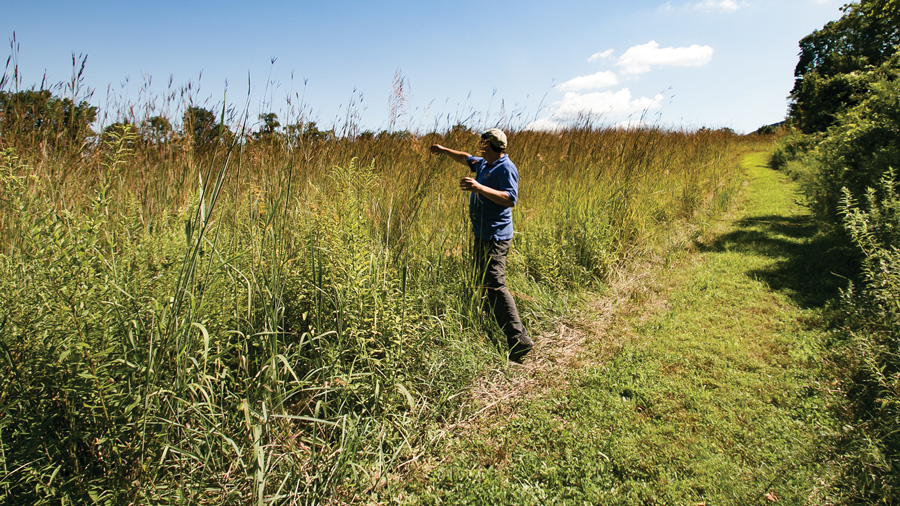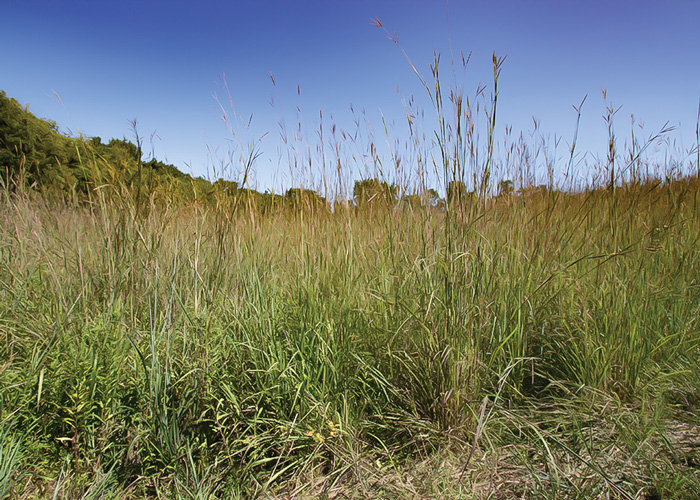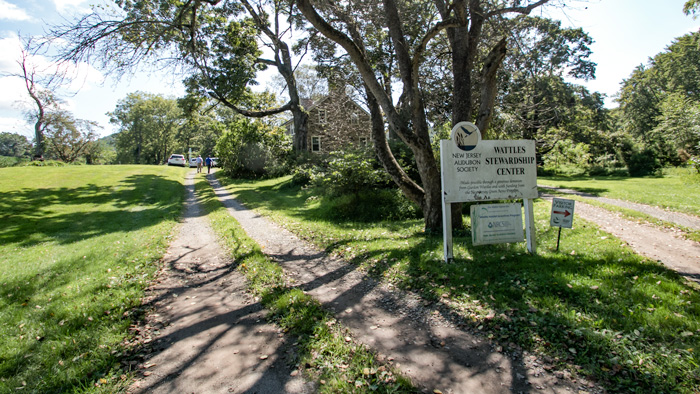The abundant fuel that kept American midwestern farming families warm through the winters of the late nineteenth century was the tallgrass that grew wild all around them across the plains, twisted into bundles and burned in rudimentary household stoves. Sometimes it was the digested dried dung of grass-eating buffalo or cattle, or straw harvested from the farmer’s field, all steady reliable sources of heat-yielding, combustible, carbon-rich biofuel. They called it “prairie coal”.

Many grasses that evolved on the prairie are hardy warm-season perennials that can survive extreme winter cold and scorching summers. Many of them are clumping plants, with root systems that run deep into the soil to enable them to withstand drought. Two grasses that covered the late-summer prairie landscape were big bluestem and Indiangrass, growing eight feet high.
Ten years ago, New Jersey Audubon was considering ways to get more grasslands on the landscape, primarily for the security of the state’s threatened bird species, most of which are grassland dependent. “Most of the existing grasslands were embedded in agriculture; “cool-season” grasses like horse hay,” explains John Parke, Audubon’s Stewardship Project Director for Northern New Jersey. Cool-season grasses are used for turf and as high-quality pasture grasses for livestock because they green-up quickly in the spring and grow well into the fall. But those pastures are not good for birds, whose annual breeding season is the same as when the farmers harvest the field for hay.
Because they offered a more hospitable growing cycle for birds, and plenty of space for them to run through fields consisting of clumps of plants rather than a dense mass of vegetation, Parke started looking at ways to get native warm-season grasses into farmers’ pastures. Although warm-season grasses are good for forage, habits are hard to break, and the market was resistant. “Even though we were giving it away for farmers to try it out for forage, it just wasn’t taking off.”

Around that same time, Pennsylvania Northeast Resource Conservation and Development (PNERCD) was having some success emulating European technologies that had been in use for decades to burn heating pellets made from grass, much like wood pellets familiar in America. PNERCD began to teach local farmers how to grow and pelletize warm-season grasses, and, in 2008, obtained a grant to build a mobile pelletizer. A series of workshops throughout the region generated interest, not only in the possibilities for residential use, but also for larger scale business and municipal use. Lancaster Farming reported that, in 2009, the Benton School District, in Columbia County, installed a boiler system that burned 210 tons of briquettes produced on site from switchgrass grown locally with minimal fertilizer and water. The district estimated that it would save more than 25,000 gallons of fuel oil, and $60,000, each year by consuming less than two-hundred acres of switchgrass purchased mostly from farmers within ten miles of the school. State funding and support from the USDA’s Natural Resources Conservation Service (NRCS) was critical for the $2.1 million project, plus loans that were projected for payback within thirteen years.
For John Parke and NJ Audubon, here was a solution that could save two birds with one stone. Warm-season grasses could provide much-needed habitat for threatened species, as well as an easily sustainable biofuel with a BTU rating similar to that of hardwood. Warm-season grass is an efficient and fast-growing solar energy collector that stores enormous amounts of carbon in their root systems that reached deep into the soil, holding it together. It is a perennial crop with minimal costs for planting, flood and drought resistant, and arable with big machines requiring minimal trips across the field for cutting and baling. Best of all, burning warm-season grass may reduce emissions by as much as 90 percent.
John and his staff at the Wattles Stewardship Center in Port Murray went about trying to create a market for grass fuel pellets at a smaller, residential scale. They found a partner at Lane Farms in Somerset County and, with funds from NRCS, started growing and pelletizing grasses for evaluation. “Ten years ago, the technology just wasn’t there to support smaller-scale biomass furnaces,” recalls John. “It was hard to get reliable equipment. If you tried to crank up the machine, pieces would literally fly off, and it was hard to get parts. We needed somebody local who had the right capabilities to produce the pellets.”

At the same time, orchid grower, Arie Van Vugt, was looking for ways to save on his huge heating bill in the giant greenhouses at Plainview Growers in Allamuchy. He brought back a team from Europe to set up a biomass furnace with a small pelletizer and demonstrated that, at a larger scale, the system was efficient and had great potential. The problem was, who was going to pelletize to supply a bigger market? Van Vugt again made a sizable investment, this time in a reliable industrial-scale pelletizer. He also had storage sufficient for the large amounts of hay that would come off the fields. What remained to be found was the market. Thus far, the only happy customer was Plainview Growers.
Scaling up the commercial market required state permitting, for which the NJ Department of Environmental Protection (DEP) had no precedent basis for regulation. For whatever reason, they used the coal standard to regulate the system’s emissions. “$65,000 for the permit,” recalls John. “And it became an issue, because the efficiency of Arie’s system was so good that there really wasn’t anything coming out of the stack. It was almost all water vapor and no particulates! Nobody could wrap their head around that. They knew they had to regulate it but didn’t know how, or what to look at, or what to permit for.”
Many local farmers were, by this time, growing warm-season grasses with subsidies from NRCS and the New Jersey Landowners Incentive program. And, at long last, there was a facility that could handle pelletizing product for heating fuel. The final piece to the puzzle was the USDA’s Biomass Crop Assistance Program (BCAP), which would help pay costs to deliver the biomass feedstocks.
“We’re about to announce that we have the first US Department of Agriculture BCAP facility on the East Coast,” remembers Parke. “The press release goes out to the state, and they come back and say ‘Wait a minute. We’re not finished with the permitting and the testing. You can’t be a BCAP facility.’ They shut it down.” Arie got fed-up and walked away, and with that hub gone, momentum died. Then corn prices went up, so everybody pulled out the grass and put in corn.
It turns out that compressing grass into pellets or briquettes is a very complex process with a steep learning curve, and that burning the end-product has its hitches. Will Brandau, who was one of the first grow and pelletize switchgrass on a large scale at his Wood Crest Farm, about twenty-five miles east of Benton, in Wapwallopen, Pennsylvania, took part in a 2014 detailed case study intended to provide practical guidance for farmers interested in pursuing the business on their own. Five years later, Brandau is no longer producing pellets.
“I gave pellets away to seven friends who had pellet stoves. Not one came back to buy pellets from me,” says Will. “That told me what the market was at that point. Grass will produce four times the amount of ash that wood does. When I burn grass, I have to empty my stove twice a day. So, I stopped making it for fuel. But I still have my pelletizer, and I anticipate starting again, but not for fuel. There have been recent studies that have shown that it’s a great mulch and makes great animal bedding. If you put the pellets in your backyard garden, and the rain hits them, they dry into a solid layer that the weeds can’t get through.” And the Benton School converted from grass pellets to wood, because the burning grass formed “clinkers”, hard silicone structures that frequently clogged the furnace augers.
Is there any way that warm-season grass pellets will ever be used for fuel in our part of the world? “It depends on the markets, right? It depends on what the real needs are. It depends on if someone’s got the foresight to think about that at a large scale. [...] Canada does it. All the research that I was using when we were trying to start this up came from there. Arie went to Europe, because they’ve been doing it forever,” answers Parke. “What’s sad about it is that the grasses are amazing ecologically because they take an extra molecule of carbon out of the air.” Most plants are classified as C-3, while the C-4 warm-season grasses use a slightly different process during photosynthesis, when they absorb sunlight and carbon dioxide from the air and convert it into energy, or carbohydrates. “Not only is it sequestering carbon, the root system on those plants goes six to ten feet below grade; not like your lawn where you can pull it right with root maybe a quarter inch into the ground. So, the root system is holding in soil, it’s helping with nutrient cycling, ground water infiltration, providing habitat for species, and there’s still agriculture that you can get out of it if you can find the right market. It’s amazing: clean air, water, soil and picking up habitat. But the reality is, who’s putting it in?”
We can put it in. In this era of drastic climate catastrophe—and when we know that further burning of carbon emitting fossil fuels are exasperating the catastrophe—our Skylands region, rich in water and mineralized soils left from the Wisconsin glacier, might be perfectly poised to promote the cultivation of warm-season grasses. They can be grown on the marginal areas of food-producing farms. Beside sequestering carbon from our polluted air, they could prevent the alarming amount of soil being eroded from the last decades of industrialized production of corn and soybeans. Both have become commodity crops to be sold elsewhere, leaving present farmland bleeding topsoil into our rivers and streams, and this region without the capacity to feed itself.
With a commitment to solving the technical challenges of the higher ash content, as has been done throughout Canada and eastern Europe, furnaces could be brought to the necessary efficiency. Farmers could be given incentives through our soil conservation services to bring these prairie grasses back into these still predominantly rural areas. Our community colleges with their technical schools could be at the forefront of preparing our young people to bring this ecologically-sound and locally produced heating fuel to their homes and communities.
It is the young people worldwide who are asking this generation for a future in which they can have hope. This innovative and ancient process, in all its simplicity, can generate their hope.